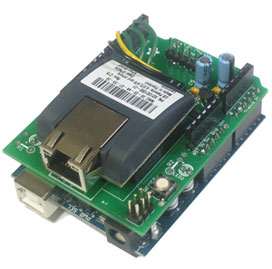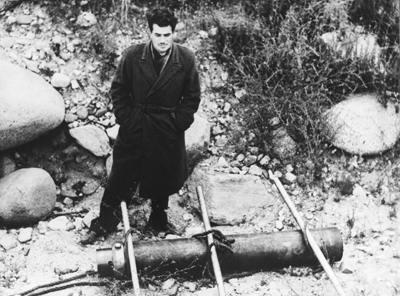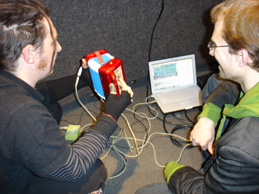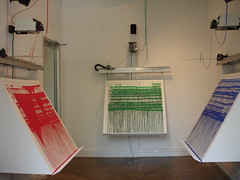[This piece originally appeared in The Absolute Beginner’s Guide to Building Robots]
Remember The Rules, that icky book written by those two insufferable women who nobody would want to date regardless of what relationship principles were or were not being applied? Well, I decided to dream up some rules of my own. No, they’re not things like “Never call a robot after the final assembly. Make it call you.” Or: “The way to a robot’s stomach is through its rear access panel.” These “rules” represent the collective working wisdom of builders who’ve been bolting together bots for decades. The cyberneticist Gregory Bateson used to say: “Always tie your ideas with slipknots.” So these are not hard and fast rules, more like rules of thumb. Just a few things to consider as you build robots.

1. A roboticist is a generalist, a systems thinker.
One of the things that attracts a lot of people (me, for one) to robotics is that it involves the orchestration of many different disciplines. There are, obviously, specialists in the field — those who work only on AI control architectures, or robot locomotion, or whatever — but even they must keep the entire machine in mind. Most people who work in the field, and certainly all amateurs, have to have at least basic skills in numerous disciplines. As you get more into robotics, you’ll also find yourself spending a lot of time looking at humans and animals trying to figure out how they work. Oddly, trying to construct machine “creatures” gives one an even greater appreciation for the heavenly designs of nature, which brings us to…
2. A roboticist is a “deconstructionist”
As a robot builder, you’ll find yourself obsessively looking at the natural and built worlds and going: “Ah-ha! So that’s how it’s done.” Nothing will be safe as you take apart toys and machines that don’t work anymore (and some that still do), and find yourself playing with your food in a manner unsettling to others (“Cool, there’s the ligament attachments!”). But, for the love of all that’s civilized, leave the family pets alone!

Aside: Rumor has it that BEAM (and Wow Wee Toys) robot inventor Mark Tilden has been known to put all manner of bio-matter (chicken and other animal bones and bits) into his dishwasher so that he can clean them thoroughly for study of their mechanics, and one might even assume, incorporation into disturbing SRL-esque bio-mechs.
3. A roboticist knows how to K.I.S.S. it.
Actually not every robot builder knows this, but they should. K.I.S.S. stands for “Keep It Simple, Stupid” and it’s a maxim recited (but frequently unheeded) in many design disciplines. Heed it in your robot building. Take time to plan your projects. Don’t just throw technology at a problem ‘cause you can. Use prototyping tech such as LEGO MINDSTORMS, VEX, and breadboarding to test out designs. Then try and figure out what you might not need and toss it. The simpler and more elegant your designs, the more likely your robot is to be stable and robust.
4. A roboticist must learn to think “outside the bot.”
Innovation comes from thinking differently, heading down the road less traveled. Don’t be afraid to take chances, to go in radical directions. Apply what I call Rodney Brooks’ Research Heuristic. Here’s how this works: In his book Flesh and Machines, Brooks reveals how he came upon many of his radical ideas regarding robots and AI: He would figure out what was so obvious to all of the other researchers that it wasn’t even on their radar, and then he’d put it on his. Essentially, Brooks would look at how everyone else was tackling a given problem, and what assumptions were so implicit to them that these assumptions were no longer being questioned. And he would question them. Don’t listen when people tell you that you can’t do something. Ignore your critics.

Aside: This is completely unrelated to robots, but it neatly illustrates our fourth rule. Many years ago, a friend of mine, a fabric artist, entered a beginner’s fabric weaving contest. She rented a small loom, learned how to weave, and decided to weave a seersucker blouse. Because she was new to weaving, she didn’t know that you “couldn’t” hand-weave seersucker (which is comprised of alternating puckered and smooth stripes). She had a devil of a time doing it, but she thought it was just because she was new to weaving. The judges were stunned. Needless to say, she won the contest, and the grand prize, a gorgeous room-sized Swedish loom that was the size of a small sailing vessel.
5. A roboticist is as much an artist as a scientist.
Find someone who’s done anything truly cutting-edge in science and technology, and chances are, he or she has a bit of an artist’s/poet’s soul. Independent engineer and self-proclaimed “high-tech nomad” Steven Roberts is often quoted as saying, “Art without engineering is dreaming. Engineering without art is calculating.”

6. A roboticist must be methodical and patient (like any scientist).
The pressure that many robot developers are under to deliver creations that live up to sci-fi-like expectations leads too many to attempt too much, too soon. Scientific development is measured, by its nature. Don’t be afraid to get one thing right rather than a bunch of things “sorta okay.” (Notice how we just contradicted rule number 4. What can we say? Rules are … well for those two ladies who wrote that book.)
7. A roboticist knows that neatness counts.
After you’ve built a few robots, you’ll quickly learn that the mechanics and (especially) the electronics can quickly become complicated, even in simple machines. There are usually wires sprouting everywhere, and trying to fit all of the parts inside your robot body, or on your robot platform, can become quite a challenge. You’ll learn that keeping everything neat and tidy will make a huge difference in the end. Use quick connectors when you can (for plugging and unplugging wires), use cable ties to bundle related wires together, and carefully plan (or revise) your design to maximize order and quick deconstruction/reconstruction of subsystems for easier troubleshooting. Color-code.

8. A roboticist must be a master of many trades.
As stated in rule number 1, a roboticist must be able to look at the big picture and know at least a little about a lot. He or she must have a working knowledge of materials sciences, structural and mechanical engineering, electrical engineering, and computer sciences. This may all sound intimidating to an absolute beginner, but knowing something about all of these areas of technology and science can actually be fun and exciting. And don’t let the big words trip you up. In plain English, these boil down to: building stuff (and knowing the right stuff to use), doing basic electronics, and knowing the ins and outs of microcontrollers and their software.
9. A roboticist should know his or her tools, materials, and processes.
You can have all the fancy “book learnin’” in the world, but if you don’t have a good working knowledge of robot building tools, building materials, and real-world construction techniques, you’re not going to be seeing robots scooting around your den anytime soon. The more you tinker, experiment, the more mad skills you’ll acquire — which leads us to…

10. A roboticist knows that you need to build early and build often.
Modern robot building technologies such as LEGO MINDSTORMS, VEX, iRobot’s iCreate, open source microcontrollers, prototyping boards, and other similar innovations (not to mention computer designing, simulation, and programming software) allow robot builders a tremendous amount of freedom to experiment and build on demand. Think of pre-PC writing tech (pens and paper, typewriters) versus a word processor (complete with spell- and grammar-checking, a built-in dictionary, Thesaurus, and so forth) and that gives you some idea of today’s robot tools versus those of a decade ago, even five years ago. Now you can have an idea for a new drive or sensor system, whatever, and have it built and tested within a few hours. If it doesn’t work, you can quickly disassemble and assemble something else. From this rapid prototyping can come truly innovative robot designs.
11. A roboticist should know when to come back later (A.K.A. “The Kenny Rogers Rule”)
When you’re building anything, especially something as complicated as a robot, the build can sometimes get ugly. If you try to force your way through, you can often dig yourself into an even deeper hole. So here’s what you do: “Put the soldering iron down. Step away from the steaming robot entrails!” You’ll be amazed at what an hour away, vegging in front of the TV, rolling around on the floor with the cat, or sleeping on your problem will do. It almost never fails. Here’s a corollary: The extent to which you don’t want to drop what you’re doing and take a break (“I know I can fix this, damn it!”), is inversely proportional to the extent to which you need a break. Why is it the Kenny Rogers Rule? Cause “you got to know when to hold, know when to fold ’em, know when to walk away…”
[“Heroes of the Robolution” trading card illos by Mark Frauenfelder, from Absolute Beginner’s Guide to Building Robots]
Other Robot Projects on Street Tech

 Bringing ethernet connectivity to the Arduino for around fifty dollars, Lady Ada’s XPort Shield has gotten people understandably excited. But with a little elbow grease and a custom firmware, you can do even better: a $10 component can bring Ethernet, wifi and a full Linux environment to your microcontroller project. Not bad, right? Tom Lee will explain how, and show a simple Arduino-based ambient display that uses the approach to show Metro schedule information.
Bringing ethernet connectivity to the Arduino for around fifty dollars, Lady Ada’s XPort Shield has gotten people understandably excited. But with a little elbow grease and a custom firmware, you can do even better: a $10 component can bring Ethernet, wifi and a full Linux environment to your microcontroller project. Not bad, right? Tom Lee will explain how, and show a simple Arduino-based ambient display that uses the approach to show Metro schedule information.














 Illustrated Guide to Home Chemistry Experiments by Robert Bruce Thompson Price: $34.99 Pre-order/Buy: Maker store –
Illustrated Guide to Home Chemistry Experiments by Robert Bruce Thompson Price: $34.99 Pre-order/Buy: Maker store – 








